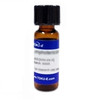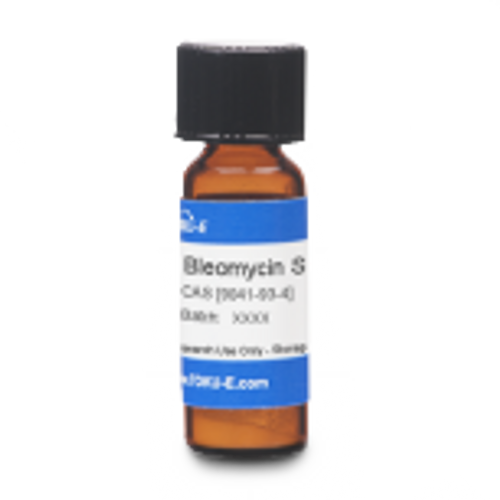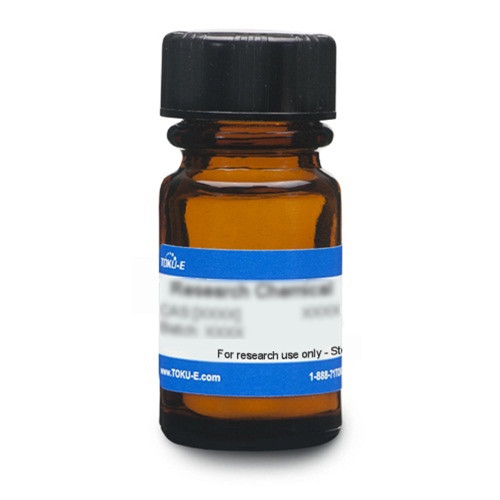Bleomycin (Syn: Bleomycin Complex) is a complex of 11 glycopeptide antibiotics originally isolated from Streptomyces verticillus in 1972. The dominant components are Bleomycin A2 and Bleomycin B2, which typically represent >90% of the total weight. Bleomycin has anti-cancer properties.
We also offer:
- Bleomycin Sulfate, USP (B005)
- Bleomycin A2 Sulfate (B019)
- Bleomycin A5 Hydrochloride (B004)
- Demethylbleomycin A2 Sulfate, EvoPure® (D023)
- Bleomycin ReadyMadeTM Solution (B096)
| Mechanism of Action | Bleomycin has activity via several mechanisms. It acts by intercalation of DNA and RNA. In the presence of oxygen and metal ions, notably copper and iron, it is believed that Bleomycin forms a pseudo-enzyme that reacts with oxygen to produce superoxide and hydroxide free radicals that in turn cleave DNA and induce single- and double-stranded breaks. Bleomycin's anticancer activities include the increase of caspase-3 and p53, and the inhibition of telomerase activity leading to apoptosis. The compound inhibits DNA synthesis and impacts G2 and M phases of the cell cycle. |
| Eukaryotic Cell Culture Applications |
Bleomycin can be used as a fibrogenic agent in animal models of experimentally induced pulmonary fibrosis. In vitro toxicity studies have indicated that in primary pulmonary artery endothelial cells (PAEC), the compound causes apoptosis via the extrinsic apoptotic pathway (A15408) (Mungunsukh et al, 2010). The native confirmation of DNA is called B-DNA, however another confirmation is A-DNA. They are both right-handed helices, but A-DNA has a larger diameter and is shorter. Different dimensions of these forms determine the different size of major and minor grooves. Researchers studied the conformational transition of DNA in living cells resulting from pharmacologically induced strand breaks. HeLa cells were treated with Bleomycin in various concentrations (50 µM, 150 µM and 500 µM) to induce DNA damage. Changes in the cell were detected using Raman micro-spectroscopy. Bleomycin treatment at 500 uM led to cell apoptosis detected as spectral changes indicating water loss, increase of cellular material density and formation of apoptotic bodies. Chromatin fragmentation, a hallmark of cell death, was observed with fluorescence imaging (Czaja et al, 2022). |
| Cancer Applications | Bleomycin contains a disaccharide moiety composed of 2 unusual sugars, L-glucose and 3-O-carbamoyl-D-mannose. Bleomycin could be regarded as a modular system composed of a tumor-targeting agent (the dissacharide moiety) and a tumoricidal agent (deglycobleomycin). The disaccharide moiety is responsible for the tumor cell targeting properties of Bleomycin. Bleomycin analogs were prepared, the glycosylated analogs were more cytotoxic to cultured DU145 prostate cancer cells. These findings establish a role for the Bleomycin disaccharide in tumor targeting/uptake and suggest that the disaccharide moiety may be capable of delivering other cytotoxins to cancer cells. Cytotoxicity testing with DU145 human prostate cancer cells in vitro (Schroeder et al, 2014).
Bleomycin is used in combination with other antineoplastic agents in studying lymphomas, testicular carcinomas, and squamous cell carcinomas. Researchers found that the human L-carnitine transporter (hCT2) is involved in Bleomycin-A5 uptake. NT2/D1 human testicular cancer cells which highly express hCT2 are very sensitive to Bleomycin-A5. Data suggest that hCT2 can mediate the uptake of Bleomycin A5 (Aouida et al, 2010). In cell culture experiments with Bleomycins and BLM carbohydrates conjugated to microbubbles, it has been demonstrated that Bleomycins are tumor-seeking molecules. Biotinylate Bleomycin A5 was attached to microbubbles, and a conjugate-containing solution was passed over a monolayer of MCF-7 cells. The microbubbles adhered to the MCF-7 cells. The conjugate did not bind to a normal breast cell line or to matched noncancer cell lines. No binding occurred if the microbubbles lacked conjugated Bleomycin A5 or if the microbubble lacked the carbohydrate moiety (Chapuis et al, 2009). A well-known characteristic of tumor cells is the Warburg effect, that is the propensity of tumor cells to produce increased ATP via glycolysis rather than by mitochondrial oxidative phosphorylation. The shift to glycolysis is accompanied by upregulation of glucose transporters to provide the greater amounts of glucose needed to support increased glycolysis. If authors treated two wild-type cell lines (normal WI-38 and normal kidney CCD-1105 KIDTr cells) with the inhibitor rotenone (a mitochondrial complex 1 inhibitor), this forced these cells to use increase glycolysis in the same fashion as tumor cells and this resulted in an enhanced ability to incorporate BLM-Cy5. The finding implies that the BLM saccharide moiety may be able to deliver other cytotoxins selectively to tumor cells (Mobasheril, 2005). |
| Molecular Formula | C55H84N17O21S3 (for A2) |
| Solubility | Bleomycin is soluble in water and methanol, with moderate ethanol solubility. |
| References |
Aouida M, Poulin P and Ramotar (2010) The human carnitine transporter SLC22A16 mediates high affinity uptake of the anticancer polyamine analogue Bleomycin-A5. J. Biol. Chem. 285:6275-6284 Burger RM, Paisach J, and Horwitz SB (1981) Mechanism of Bleomycin action: In vitro studies. Life Sci. 28(7):715-727 PMID 6164898Chapuis J, Schmaltz RM, Tsosie KS, Belohlavek M and Hecht SM (2009) Carbohydrate dependent targeting of cancer cells by Bleomycin-microbubble conjugates. J. Am. Chem. Soc. 131(7):2438-2439 Czaja M et al (2022) Raman research on Bleomycin-induced DNA strand breaks and repair processes in living cells. Int. J. Molec. Sci. 23(7):3524 Dorr, RT (1991) Bleomycin Pharmacology: Mechanism of action and resistance, and clinical pharmacokinetics. Semin. Oncol. 19(2): 3-8 PMID 1384141Fujiwara Y and Kondo T (1973) Strand-scission of HeLa cell deoxyribonucleic acid by Bleomycin in vitro and in vivo. Biochem. Pharmacol 22(3):323-333 PMID 4119868 Kross et al (1982) Structural basis for the deoxyribonucleic acid affinity of Bleomycins. Biochem. 21: 3711-3721 PMID 6180763 Kross et al (1982) Specificity of deoxyribonucleic acid cleavage by Bleomycin, phleomycin and tallysomycin. Biochem. 21:4310 PMID 6181807 Mobasheril, A, Richardson S, Mobasheri R, Shakibaei M, Hoyland, J (2005) Hypoxia inducible factor-1 and facilitative glucose transporters GLUT1 and GLUT3: Putative molecular components of the oxygen and glucose sensing apparatus in articular chondrocytes. Histol. Histopathol. 20(4):1327-1338 PMID 16136514 Mulsant P, Gatignol A, Dalens M and Tiraby, G (1988) Phleomycin resistance as a dominant selectable marker in CHO cells. Som. Cell and Mol. Gen. 14(3):243–252 PMID: 2453083 Mungunsukh O, Griffin AJ, Lee YH, Day RM (2010) Bleomycin induces the extrinsic apoptotic pathway in pulmonary endothelial cells. Am J Physiol Lung Cell Mol Physiol. 298(5):L696-703 PMID 20154224 Schroeder BR et al (2014) The disaccharide moiety of Bleomycin facilitates uptake by cancer cells. J. Am. Chem Soc. 136(39):13641-13656 Takita T et al (1972) Chemistry of Bleomycin. IX. The structures of Bleomycin and phleomycin. J. Antibiot. (Tokyo) 25:755-757 PMID 4119701Yang L, Yang S, Tai K, Chou M and Yang J (2004) MEK inhibition enhances Bleomycin A5-induced apoptosis in an oral cancer cell line: Signaling mechanisms and therapeutic opportunities. J. Oral Path. and Med. 33(1):37-45
|








